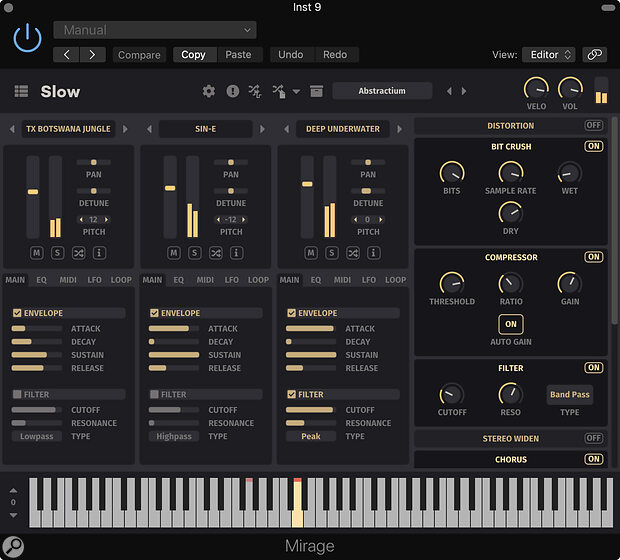Rating: **** 4/5 Stars
FrozenPlain Slow is an instrument offering a selection of mainly gentle sounds that would slot well into ambient or New Age compositions, though there are a few slightly more edgy sounds in there too. As with previous FrozenPlain instruments I’ve reviewed, the compact sound library runs on the Mirage player engine under VST or AU hosts — AAX is not listed. Most of the sound sources are pitched but there are also unpitched textural examples including the sound of water and various processed noise samples. Any of the sounds can be further shaped using the Mirage engine’s envelope, looping and filter functions as well as its effects rack and convolution section.
If you already have other Mirage libraries, these can be accessed using the library browser pane, though you still can’t layer sound combinations from different libraries. Each patch can comprise up to three sounds, each of which has its own set of controls for envelope, level, pitch and filtering. The basic sound source elements are divided into Textures and Tonals. In the master section you’ll find the standard Mirage effects rack offering Distortion, Bit Crush, Compressor, Filter, Stereo Widen, Chorus, Reverb, Delay and Convolution, all with fairy simple stompbox‑style controls. Any control can be mapped to a physical MIDI controller via a Learn function and DAW parameter automation is supported.
The factory presets are arranged into categories: Basses, FX, Keys, Noise Textures, Pads and Pulsers. These designations give you a good idea of what to expect. I found some of the Keys presets to be a bit aggressive for the genre but they can easily be tamed using filters and more abstract convolution options such as the Shimmer, Formant or Space Digeridoo. The convolution section really does make a huge difference to the overall sound and should be considered as one of the more important sound‑shaping tools as it goes far beyond standard reverb.
Most of the gentle sounds reside in the Pads section, where you’ll find plenty of piano‑meets‑organ‑meets‑‘host of angels’ patches alongside organ‑esque pads and more textural offerings.
Noise Textures are often effective when layered with other synth sounds to add a little Wavestation‑style complexity, and while the Bass section offers little that’s new, there are some very usable sounds to be had. I also rather liked the Pulsers section, which injects a rhythmic element into the sounds.
Given the low cost of this instrument alongside its very straightforward interface, I found it very appealing with plenty of potential outside its New Age leanings.
$59
$59

